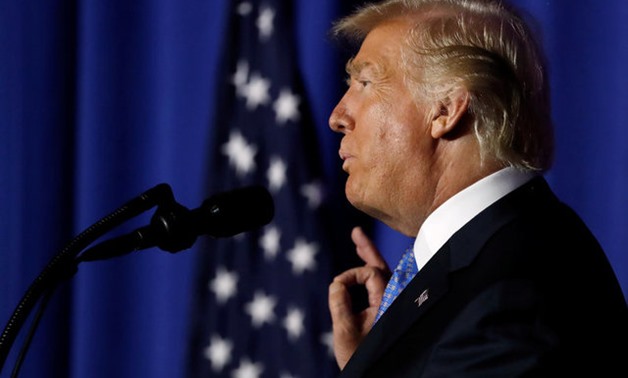
Trump delivers remarks on proposed changes to the tax code at an event in Indianapolis - REUTERS
LONDON - 28 September 2017: The dollar and global borrowing costs rose on Thursday after President Donald Trump proposed the biggest shake-up of the U.S. tax system in three decades and strong data supported the case for another Federal Reserve rate hike later this year.
The dollar's strength pressured many emerging market currencies and commodities, but Europe's main stock markets gave Trump's blueprint the cautious thumbs up after Wall Street and Japan's Nikkei had gained overnight.
Banks rose 0.7 percent to fresh seven week highs, though that was partly offset as miners struggled and as underwhelming results from one of Europe's biggest fashion chains, H&M, weighed on retailers.
The prospect of higher U.S. debt levels and expectations for another Fed hike had sent 10-year Treasury yields to their highest since mid-July, with the 2-10 year yield curve steepening to its highest in a month.
The week’s dollar rally continued, meantime. Its gains were most marked against Japan’s yen, where it probed above 113 yen. Traders also eyed the jump in Japan’s 10-year government bond yield toward levels where the Bank of Japan would be expected to buy bonds to maintain its zero percent target for long-term rates.
Euro/dollar meanwhile held just above $1.17, with European benchmark bond yields climbing in the slipstream of Treasuries too.
The 10-year TransAtlantic yield gap between U.S. and German debt widened to 185 basis points however, which was its widest since early July.
"The market had given up on the Trump reflation trade and this is coming back with a bit more detail on tax plans," said Commerzbank analyst Rainer Guntermann.
"At the same time, this gives the Fed more ammunition to hike rates in the coming months."
Emerging markets were the big losers from the dollar and Treasury yield spike higher. MSCI’s emerging markets equity index was down 0.6 percent and was on course for its sixth straight daily decline.
If it holds it would be the index’s longest losing streak since May 2016 and it is also down almost 4 percent in the last 10 days.
TAXING TIMES
Trump's tax plan offered to lower corporate income tax rates, cut taxes for small businesses and reduce the top income tax rate for individuals.
Also helping to boost the dollar, the plan included lower one-time low tax rates for companies to repatriate profits accumulated overseas, which analysts say would lead to a temporary phase of sizable dollar buying.
Others noted though it could be an uphill battle to get the changes approved. "It is hard to expect this proposal to pass the Congress smoothly." Takafumi Yamawaki, chief fixed income strategist at J.P. Morgan Securities.
"We have to pay attention to how the Republicans will view this," he added "It is possible that the net fiscal spending will be smaller than what the stock markets expect."
For now though that seemed too far away to worry about. The euro hit a six-week low of $1.1717 as the dollar broadly gained, and last traded at $1.1729, having shed 1.9 percent so far this week.
There was also data in play. German inflation figures were already dribbling in while economists were also waiting for euro zone wide economic confidence readings due at 0900 GMT.
YIELDS
The greenback did check back against the yen easing off to 112.82 yen to the dollar having hit a 2-1/2-month high of 113.26 yen the previous day.
The Canadian dollar extended its losses though, after suffering its biggest drop in eight months on Wednesday, after Bank of Canada Governor Stephen Poloz dampened expectations for further interest rate hikes this year.
Canada's loonie was last at C$1.2483 to the U.S. dollar, having early slid to its lowest in a month.
U.S. bond yields jumped with the yield on two-year notes rising to a nine-year high of 1.49 percent in anticipation of a rate rise in December.
Comments earlier in the week from Fed Chair Janet Yellen that the U.S. central bank needs to continue with gradual rate hikes have cemented expectations for policy tightening by year-end.
New orders data on Wednesday for key U.S.-made capital goods also grew more than expected, helping to boost optimism in the U.S. economy's outlook.
The 10-year yield rose as far as 2.357 percent, its highest in more than two months, while the 30-year bond yield climbed to 2.901 percent having seen its biggest one-day rise in almost seven months.
Commodities prices were also dented by the revitalised dollar.
Brent eased to $57.61 a barrel, down from Tuesday's 26-month peak of $59.49, while U.S. West Texas Intermediate crude (WTI) fetched $52.05 per barrel having struck five-month high of $52.43 also on Tuesday.
Gold which is often regarded as a safe-haven but an asset which has little to offer when inflation is rising, fell to a more than one-month low of $1,278.36 per ounce though industrial metals like copper edged higher.

Comments
Leave a Comment